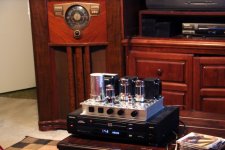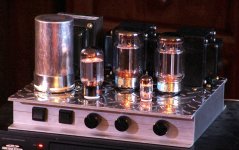I am looking at a couple of different OPT options. Both are rated at 20W, 5K primary and 8R secondary.
One of them specifies 80mA (or less) primary DC recommended, with a max of 140mA. The other states it is air gapped for 100mA and has a max of 250mA.
Those appear to be substantial differences and I don't understand the implications. Please enlighten me.
One of them specifies 80mA (or less) primary DC recommended, with a max of 140mA. The other states it is air gapped for 100mA and has a max of 250mA.
Those appear to be substantial differences and I don't understand the implications. Please enlighten me.
A typical non SE specific OPT has an interleaved core stack. Every E and I lamination is inserted the other way around, or every few E and I face the other direction. This creates a continuous magnetic circuit through the core. This will cause the core to saturate if there is any residual DC current through the windings since the transformer just becomes a big electromagnet with all the magnetism concentrated in the core.
An SE specific OPT has a gap in the core to break the magnetic circuit which will eliminate the DC response. This is usually accomplished by stacking all the Es one way and stacking or glueing all of the Is together and placing them across the top of the ends of the Es. There is a gap between the ends of the Es and the Is. This can be air and in this case the end bells are responsible for keeping the gap constant. These transformers are often hand tuned for a certain current and then the bolts are tightened. This is why you DO NOT loosen the bolts holding an SE transformer together if you can see a pure air gap at one end, usually the top.
Most SE transformers used a fixed gap width enforced by a plastic or paper spacer between the Es and Is. This facilitates dipping the whole thing in a varnish coating once done creating a more robust part.
Every SE OPT will have an optimum gap width for a given DC current, or a DC current for a given gap width where the low frequency response and power level before onset of saturation begins is optimum. OPT saturation creates an ugly sounding distortion on most music since it will affect all frequencies, not just the bass that's causing it. This was exploited on some guitar amps to create a fuller sound.
The 80 mA primary DC recommended transformer was designed for use at or near 80 mA through the output tube. 140 ma is likely the point where severe distortion occurs or long term use may cause heat related damage. The 100 mA transformer has a gap that is optimized for 100 mA. The 250 mA maximum is just that, a rating where damage may occur, or the sound would probably not be what you wanted to hear.
If you are looking at a typical EL34, or 6L6GC amp that will run at 60 to 80 mA bias current, go for the 80 mA transformer and don't stuff KT88's into the amp with the current cranked up to 100+ mA. That amp would do fine with KT88's or 6550's running at 80 mA.
I had (recently sold) an SSE that ran KT88's or 6550's at a bit over 100 mA, but could be turned down to 70 mA for EL34's. It had a pair of 3 k ohm Transcendar's that were gapped for 100 mA in it. I could run just about anything in it, but EL34's in triode at 60 mA sounded better in the other SSE with 70 mA transformers and a 5K load.
Note that cranking up the current in a tube beyond the "typical" use point does not make any more power. It does slightly improve the damping factor which will improve the bass in SOME speakers. My old Yamaha NS-10M Studio monitors did like more tube current. Full range speakers designed for SE tube amps typically don't benefit from high tube current.
An SE specific OPT has a gap in the core to break the magnetic circuit which will eliminate the DC response. This is usually accomplished by stacking all the Es one way and stacking or glueing all of the Is together and placing them across the top of the ends of the Es. There is a gap between the ends of the Es and the Is. This can be air and in this case the end bells are responsible for keeping the gap constant. These transformers are often hand tuned for a certain current and then the bolts are tightened. This is why you DO NOT loosen the bolts holding an SE transformer together if you can see a pure air gap at one end, usually the top.
Most SE transformers used a fixed gap width enforced by a plastic or paper spacer between the Es and Is. This facilitates dipping the whole thing in a varnish coating once done creating a more robust part.
Every SE OPT will have an optimum gap width for a given DC current, or a DC current for a given gap width where the low frequency response and power level before onset of saturation begins is optimum. OPT saturation creates an ugly sounding distortion on most music since it will affect all frequencies, not just the bass that's causing it. This was exploited on some guitar amps to create a fuller sound.
The 80 mA primary DC recommended transformer was designed for use at or near 80 mA through the output tube. 140 ma is likely the point where severe distortion occurs or long term use may cause heat related damage. The 100 mA transformer has a gap that is optimized for 100 mA. The 250 mA maximum is just that, a rating where damage may occur, or the sound would probably not be what you wanted to hear.
If you are looking at a typical EL34, or 6L6GC amp that will run at 60 to 80 mA bias current, go for the 80 mA transformer and don't stuff KT88's into the amp with the current cranked up to 100+ mA. That amp would do fine with KT88's or 6550's running at 80 mA.
I had (recently sold) an SSE that ran KT88's or 6550's at a bit over 100 mA, but could be turned down to 70 mA for EL34's. It had a pair of 3 k ohm Transcendar's that were gapped for 100 mA in it. I could run just about anything in it, but EL34's in triode at 60 mA sounded better in the other SSE with 70 mA transformers and a 5K load.
Note that cranking up the current in a tube beyond the "typical" use point does not make any more power. It does slightly improve the damping factor which will improve the bass in SOME speakers. My old Yamaha NS-10M Studio monitors did like more tube current. Full range speakers designed for SE tube amps typically don't benefit from high tube current.
Thank you George for taking the time to provide such a complete and helpful explanation. I appreciate it very much.
I do intend to try KT88s in this amp and looking around on the internet it seems they would be quite happy running @ 80mA (or a bit less).
I do intend to try KT88s in this amp and looking around on the internet it seems they would be quite happy running @ 80mA (or a bit less).
Last edited:
I had a switch with multiple different cathode resistors in my SSE to allow for current levels from about 60 to well over 100 mA. Most of the time these Electro Harmonix KT88's ran at 75 mA or so. They got cranked up to about 105 mA whenever I hooked the SSE up to these open backed old radios that contained Hawthorne Silver Iris 15 inch drivers. The extra current fixed the boomy bass in the uncontrolled damping of the open back radios. I also cranked up the current with my Yamaha's when playing something bass heavy like Depeche Mode or ZZ Top. The KT88s worked in the SSE / Yamaha combination for most music, but I tended toward EL34's with the Yamaha's unless I wanted to get loud.
I still have those old KT88s. They have to be at least 12 years old now and still work great despite the abuse. It seems that the newer EH and other Mike Mathews Russian brands don't last that long anymore.
I still have those old KT88s. They have to be at least 12 years old now and still work great despite the abuse. It seems that the newer EH and other Mike Mathews Russian brands don't last that long anymore.
Attachments
Using your simulations as a rough guide, I used 560R cathode resistors to begin with. I may have to replace those after I measure actual B+ as built.
I haven't purchased any KT88s yet. What I have on hand currently from guitar amp applications are pairs of:
I haven't purchased any KT88s yet. What I have on hand currently from guitar amp applications are pairs of:
- Tube Store Preferred Series EL34
- JJ EL34 II
- TAD 6L6GC-STR
- TAD 6L6WGC-STR
- Reissue Gold Lion KT66
So you have a working amp then? With what OPT's?I may have to replace those after I measure actual B+ as built.
jeff
No. Thus far I only have the PCB fully populated. The next step is to order the transformers and inductor, then hook it all up and keep fingers crossed 🙂
Per George's advice I will start off with the amp wired in triode mode, no CFB and adapt from there to experiment. However, I have included the inductor (choke) and supplemental cap in my layout from the get-go.
Per George's advice I will start off with the amp wired in triode mode, no CFB and adapt from there to experiment. However, I have included the inductor (choke) and supplemental cap in my layout from the get-go.
You looking at Hammond?The next step is to order the transformers and inductor,
jeff
Hammond and Edcor were both on my list, primarily as price reference points. I'm leaning more to this one from Thermionic Lab:
Thermionic OPT
They were mentioned in a couple of threads here so I investigated and eventually ordered a pair (different model) to upgrade a SE EL84 kit that I built. I have been very pleased with the sound and the build quality, and the service was excellent.
Will decide in the next few days and then press on to the finish line.
Thermionic OPT
They were mentioned in a couple of threads here so I investigated and eventually ordered a pair (different model) to upgrade a SE EL84 kit that I built. I have been very pleased with the sound and the build quality, and the service was excellent.
Will decide in the next few days and then press on to the finish line.
- Home
- More Vendors...
- Tubelab
- SSE OPT DC Current Question

